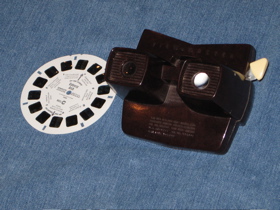Stereo Pair 3D Displays

Introduction
Like the parallax technique just described, we create two separate images of the scene, one for each eye. The difference is that these two images are presented separately, and some sort of viewing apparatus is needed to form a merged view. A very old device for this purpose is the View-Master viewer. A circular card like that shown contains pairs of left eye – right eye images, and when inserted into the View-Master, a single merged stereoscopic view appears. Flipping the lever on the right of the View-Master switches from one stereo pair to the next on the card.
Head-mounted displays might be considered a modern interactive version of the View-Master. Such displays are worn by the user like over-sized goggles and are driven by a computer that projects the left and right eye images onto small screens in front of each eye. Like the Viewmaster, only one person at a time can see the display. That fact coupled with their typical high cost limits their use.
In the remainder of this section, we will study multi-user stereo technologies. These approaches project both the left and right eye images onto a common shared screen. Some mechanism is then required so that the left (right) image is only "seen" by the left (right) eye. Two general approaches are used:
- Active stereo: left and right images are alternately presented on the screen, while the right and left eyes are alternately blocked.
- Passive stereo: both left and right images are simulataneously and continuously presented, and some other means is used to "filter out" the left (right) image from the right (left) eye.
We now discuss each of these in turn.

